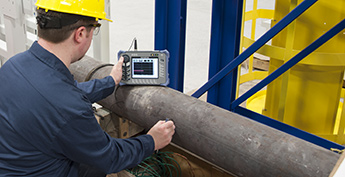超声缺陷探测辅导
 Ultrasonic flaw detection is a powerful NDT technology and a well established test method in many industries, however it can seem complex to a person who has not worked with it. This self-guided tutorial provides a basic introduction to ultrasonic flaw detection, both for newcomers and for more experienced users who want a review of basic principles. It begins with a description of what ultrasonic flaw detection is and how it works, then outlines some considerations for selecting probes and instruments. It discusses instrument calibration and some basic test procedures, outlines applications, and reviews common methods for flaw sizing. A flaw detection glossary is also provided. This tutorial covers conventional ultrasonic flaw detection. A closely related technique, phased array inspection, is discussed in our Phased Array Tutorial. Another NDT technique for flaw detection is eddy current testing, discussed in our Introduction to Eddy Current and Eddy Current Array Tutorial. Please note that this tutorial is intended as an overview of ultrasonic flaw detection and is not a substitute for appropriate operator training, which may include organized classroom work and hands-on experience where required by applicable regulations and codes. |
1.0 Introduction1.1 General Introduction to Ultrasonic Testing 1.2 History of Ultrasonic Flaw Detection 1.3 Flaw Detection Applications Overview 1.4 Types of Equipment Available 2.0 Basic Ultrasonic Theory2.1 What is Ultrasound? 2.2 Generating Ultrasound 2.3 Wave Propagation 2.4 Beam Characteristics 2.5 Wave Front Dynamics 3.0 Instrument Overview3.1 General Description of Flaw Detectors 3.2 Flaw Detector Block Diagram 3.3 Digital Signal Processing 3.4 Pulser and Receiver Operation 3.5 Display Formats 3.6 Calibration Concepts 3.7 Typical Specifications 4.0 Basic Setup Techniques4.1 General Concepts of Transducer Selection 4.2 Typical Straight Beam Contact Setup Procedure 4.3 Typical Angle Beam Setup Procedure 4.4 Typical Dual Element Setup Procedure 4.5 Typical Delay Line and Immersion Setup Procedure 5.0 Basic Approaches for Inspection6.0 Basic Construction Weld Inspection Concepts6.1 Welding Overview (Types and Descriptions) 6.2 Angle Beam Probe Selection 6.3 Probe Positions with Respect to Weld Geometry 6.4 Common Test Practices 6.5 Typical Screen Display Information 6.6 Basic Waveform Interpretation 6.7 Inspection Codes 7.0 Other Common Applications7.1 Primary Metals 7.2 Shafts, Forgings, and Bolts 7.3 Spot Welds and Braze Joints 7.4 Castings 7.5 Manufacturing Applications 7.6 Fiberglass and Composites 8.0 Sizing Techniques8.1 DAC and TVG 8.2 DGS/AVG 8.3 AWS D1.1 8.4 API 8.5 Curved Surface Correction (CSC) 9.0 Advanced Techniques9.1 Tip Diffraction 9.2 CDS/Creeping Waves 9.3 B-scan 9.4 Dual Element Angle Beams (TRL Testing) 9.5 High Temperature Testing 9.6 Phased Array 10.0 Glossary |
